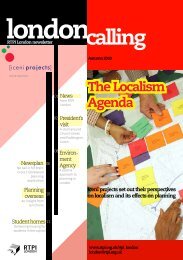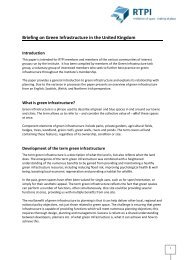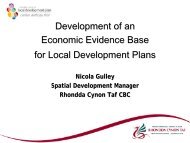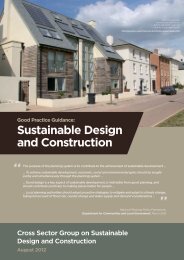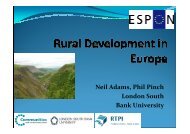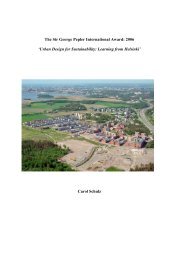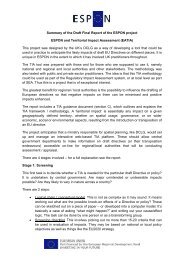James Hooker, RTPI Cymru and Welsh Government
James Hooker, RTPI Cymru and Welsh Government
James Hooker, RTPI Cymru and Welsh Government
- No tags were found...
Create successful ePaper yourself
Turn your PDF publications into a flip-book with our unique Google optimized e-Paper software.
National Planning Policy onWater: The Planner’s view<strong>James</strong> <strong>Hooker</strong> (M<strong>RTPI</strong>)Senior Planning Manager<strong>Welsh</strong> <strong>Government</strong><strong>RTPI</strong>/CIWEM Seminar – Water <strong>and</strong>PlanningFriday 24th February 2012
Research Reproductive Endocrinology <strong>and</strong> Infertilitywww.AJOG.orginto a decision tree comparing typesof tubal ligation—type A or B—vsIVF 5-7,11-18 (Table 1). The average pregnancyfollowing surgery was 12-24months, the range within the literaturewas 2-88 months. Society for AssistedReproductive Technology (SART) rateswere used to estimate live birth rates fromassisted reproductive technologies (ART)based on age <strong>and</strong> risk of multiples wasbased. 17,18 Only fresh IVF outcomes wereconsidered. Each scenario that used ARTwas allowed to run a total of four roundsto simulate the number of times insurancewould cover attempted pregnancywith IVF in states with state m<strong>and</strong>atedinsurance.Although insurance companiesmay cover a different number ofcycles depending on their policy <strong>and</strong> therespective state, we chose to allow ourmodel to run four times to simulate amiddle range number of cycles covered instates with m<strong>and</strong>ated insurance. Threeseparate trees were created to comparepatients of the following ages: less than 35years of age, 35 to 40 years of age, <strong>and</strong>greater than 40 years of age. The decisiontree model was constructed using Tree-Age version 3.5 (Tree Age Software, Williamstown,MA).Costs for tubal reanastomosis <strong>and</strong> IVFwere extrapolated from published data<strong>and</strong> were adjusted to 2012 US dollarsusing the medical care component ofthe Consumer Price Index 13,17,19-24(Table 2). Studies that described costswere preferred <strong>and</strong> chosen when available.When only charges were available,they were converted to costs using 0.6cost-to-charge ratios. Costs were alsoconverted from foreign currency to USdollars with the average exchange ratesfor that given calendar year. 25 The studyalso incorporated delivery costs ofsingleton; twin <strong>and</strong> multiple births toaddress the impact of high order multipleswith ART. 17 Only direct costs wereconsidered.The effectiveness measure in theanalysis was live birth, <strong>and</strong> the primarycost-effective outcome was the marginalcost (USD) per live birth for each strategy.The primary outcome of the decisionanalysis is cost per live birth. Ectopicpregnancies are increased in patientswith a history of tubal reversal <strong>and</strong> inTABLE 2Cost estimatesService Base case (range) Charge or cost ReferenceLSC tubal$8006.67 ($1097.87e8006.67) Cost13,19,20reanastamosisDelivery cost singleton $15,238.63 Charge17Delivery cost twins $58,736.43 Charge17Delivery cost triplets $169,900.22 Charge17IVF cycle $10,043.32($7,363.67e16,015.99/cycle)Charge <strong>and</strong> cost13,20-24All cost expressed in 2012 US dollars; older references were adjusted to 2012 US dollars using the Consumer Price Index.IVF, in vitro fertilization; LSC, laparoscopic.Hirshfeld-Cytron. Cost effectiveness tubal reversal <strong>and</strong> IVF. Am J Obstet Gynecol 2013.patients that have undergone ART.Ectopic pregnancy is estimated at 2% inthe general population <strong>and</strong> in one studycomparing ectopic pregnancy in tubalreanastomosis vs in ART was 6.7%vs 5.6%, respectively. 26 Thus, ectopicgestation is at increased risk for patientsin both groups.The most effective <strong>and</strong> least costly isnoted as the dominant strategy in themodel. Difference in cost <strong>and</strong> effectivenesswere used to calculate the marginalcosts <strong>and</strong> marginal effectiveness respectivelyfor each model. One-way sensitivityanalysis was used to test themodel’s probability changes <strong>and</strong> costs,with base cases <strong>and</strong> ranges derived frompublished data. When ranges were notavailable from literature, the rangewas set at 50% of the case base value.Two-way sensitivity analyses were alsoconducted.The study was considered exempt bythe institutional review board at Universityof Illinois Medical Center AtChicago.RESULTSDecision trees were formulated for eachage group using cost-based estimates.Base-case estimated costs were cheapestfor Type A reanastomosis per live birth atevery age. It was estimated at $19,300/live birth a for 35 years old, $23,000/livebirth at 35-40 years old, <strong>and</strong> $26,200/ livebirth for woman greater than 40 yearsof age. Marginal costs for type Breanastomosis <strong>and</strong> IVF ranged from$1000e8000. Type A reanastomosis wasalso more effective per live birth for eachage group compared with the other 2strategies, <strong>and</strong> thus the dominating orpreferred strategy. This was true for all 3ages using base-case estimates (Table 3).The marginal cost effectiveness (ie,each additional live birth performedwith type B tubal reanastomosis <strong>and</strong> IVFcompared with type A tubal reanastomosis)was $58,300 <strong>and</strong> $30,900,respectively, for the youngest age cohort.In the 35 to 40-year cohort, the marginalcost effectiveness was $111,000 <strong>and</strong>$44,000 respectively for type B reanastomosis<strong>and</strong> IVF. Lastly, the marginalcost-effectiveness for the oldest agecohort was $38,400 <strong>and</strong> $9,540 for typeB reanastomosis <strong>and</strong> IVF, respectively(Table 3). Laparoscopic reanastomosisof a prior clip or ring tubal ligation(type A) dominated the other lessfavorable (type B) <strong>and</strong> IVF at every age.In other words, it was more effective <strong>and</strong>less costly than type B reanastomosis orIVF. Type B reanastomosis also dominatedIVF in that it was more effective<strong>and</strong> less costly.The marginal cost effectiveness estimateswhen comparing the 2 tubaltypes are higher values because efficacyis almost equivalent between the 2tubal types. Because marginal costeffectivenessis calculated by marginalcost divided by marginal effectiveness,the small denominator results in a largeestimated cost difference.One-way sensitivity analysis was performedto demonstrate the robustness ofthe model. When women were older56.e3 American Journal of Obstetrics & Gynecology JULY 2013
Background One in six properties inEngl<strong>and</strong> <strong>and</strong> Wales are atrisk of flooding fromrivers, the sea, or surfacewater Annual cost of flooddamage to properties inthe UK is estimated to beat least £1.3 billionTewkesbury High Street
PPW (4.2.8) Planning for the consequencesof climate change means recognising:•Changes to our climate over the next 30 or 40years caused by past emissions are largelyunavoidable.•Failure to prepare for the inevitable impactsthrough adaptation measures will lead tofurther vulnerability for communities throughdamage to property, infrastructure <strong>and</strong> theeconomy.•We need to plan for these impacts, reducingthe vulnerability of our natural environment<strong>and</strong> built environment to climate change.
Clearly it is notsustainable togrant planningconsent forinappropriatelydesigneddevelopments inareas at risk fromflooding whichwill requiresignificant publicexpenditure inthe future.panoramio.com
National PolicyFlood RiskWalesPlanning Policy Wales & TAN15 “Direct new development away from those areaswhich are at a high risk of flooding” “development does not increase the risk of floodingelsewhere” “escape <strong>and</strong> evacuation routes are shown by thedeveloper to be operational under all conditions”. “a proposed development must provide a safe <strong>and</strong>secure living <strong>and</strong>/or working environmentthroughout its life”
“Given currentuncertainty as to theprecise impacts ofclimate change,planning authoritiesneed to ensure thatboth places <strong>and</strong> thedevelopment that takesplace within themremain adaptable”
Engl<strong>and</strong>Draft National Planning Policy Framework “avoid inappropriate development in areas at risk offlooding by directing development away from areas athighest risk or where development is necessary, makingit safe without increasing flood risk elsewhere” “local planning authorities should adopt proactivestrategies to mitigate <strong>and</strong> adapt to climate change”
“Using opportunities offered by new development toreduce the causes <strong>and</strong> impacts of flooding” “ensure flood risk is not increased elsewhere” “must demonstrate that the development will besafe for its lifetime” “development is appropriately flood resilient <strong>and</strong>resistant, including safe access <strong>and</strong> escape routeswhere required, <strong>and</strong> that any residual risk can besafely managed”
Sustainable DrainagePPW identifies: A catchment wide perspective should beadopted including the use of SustainableDrainage Systems, where appropriate Development proposals should seek toreduce, <strong>and</strong> certainly not increase additionalrun-off from development in any location Surface water run-off is to be controlled asnear to the source as possible by the use ofsustainable drainage systems
Draft National Planning Policy Framework& PPS 25 Development gives priority to the use ofSustainable Drainage Systems. – NPPF Priority to the use of infiltration drainagesystems first over watercourses <strong>and</strong> thensewers. – PPS25
Permitted Development Rights <strong>Welsh</strong> <strong>Government</strong> Consultation(2011) on amending HouseholderPermitted Development Rights –porous paving required in both front<strong>and</strong> back garden. Engl<strong>and</strong> PDRs relate to frontgardens only <strong>and</strong> areas of 5m 2 ormore.
Foul Sewerage & Water SupplyPPW ensure that appropriatesewerage facilities areprovided to convey, treat <strong>and</strong>dispose of waste water inaccordance with appropriatelegislation <strong>and</strong> sustainabilityprinciples.
New development should be located <strong>and</strong> itsimplementation planned in such a way as toallow for sustainable provision of waterDeveloper 3Developer 1services, in particular minimising vulnerabilityto the impacts of climate change. The adequacy of water supply <strong>and</strong> thesewage infrastructure are material inconsidering planning applications <strong>and</strong>appeals.Developer 2
Development proposals in seweredareas must connect to the main sewer,<strong>and</strong> it will be necessary for developersto demonstrate to local planningauthorities that their proposal site canconnect to the nearest main sewer.
Code For Sustainable Homes 2010Sur 1 & Sur 2
lood Map for Surface Water• SFCAs• FCAs – stillmay beneeded.1 in 200 rainfall probability- flooding in TorbayDeeperShallowerBlue dots representflooded property records
Thought for the Future• Should flood risk, surface waterdrainage, <strong>and</strong> water/sewerageconnections be materialconsiderations – orshould they be legal requirementsthat have to be satisfied so l<strong>and</strong> isused sustainably in the future?
Thank youIntroductory Briefing:Transportwww.wales.gov.uk<strong>James</strong> <strong>Hooker</strong>james.hooker@wales.gsi.gov.uk







